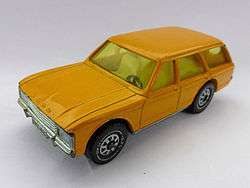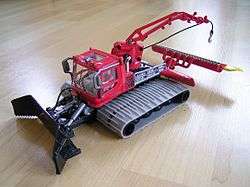Siku Toys

SIKU is the range of toy vehicles and related products produced by the German company Sieper Lüdenscheid GmbH & Co. KG in Lüdenscheid, Germany. The company manufactures many vehicles, but the Super Series 1:55 scale die-cast line is the core product, thus Siku historically could be seen as the "German Matchbox". The company also owns the well known HO scale producer Wiking-Modellbau.
History
Sieper-Werke (The Sieper company) was founded in 1921 (Wagner 2002-2007). It was originally a manufacturer of metal tools and cutlery in zamac and aluminum and, later on, ashtrays, badges, medals, belt buckles, and buttons (Wagner 2002-2007). The factory in Ludenscheid was outfitted with new casting molds in 1949 for grating, sandblasting and painting zinc cast goods. The company was even contracted to make Mercedes-Benz's star-shaped hood ornament (Natrop 1998-2002).
The company also experimented with early plastics. In 1943 the company expanded to a facility in Hilchenbach, about 30 miles from Lüdenscheid, though the latter has always been Sieper-Werke's headquarters. Still, consumer products like plastics, furniture, mirrors and cabinets have been developed and manufactured in Hilchenbach. Lüdenscheid, in turn, generally focused on promotional items for major brands, such as the 'elephant shoe' and 'Zeller black cat' which were produced by injection molding.
It was not until 1950 that the company started producing toys in Lüdenscheid, registering the trademark SIKU for the new products. SIKU originates from abbreviating the name of the founder of the company, Richard Sieper, and the German word for plastic, Kunststoffe (e.g. Sieper Plastics). Originally, there was a broad variety of SIKU toys which at first were plastic, including figures and animals. These were often called 'margarine figures' because they came in margarine packages as a food promotion (Natrop 1998-2002). The success of the plastic figures gave capital to start a post-war vehicle line.
Between 1951 and 1955, the first vehicles were generic representations of a fire truck, a race car, an amphibious truck, a moving van, and finally, in 1955, a Porsche 356 (Natrop 1998-2002; Wagner, 2002-2007). The scale chosen was approximately 1:60. By 1958, SIKU had dropped figures to focus exclusively on the plastic vehicles, except where animals attended tractors and such.
Model Ranges
V-Series plastic
In 1955, the first dedicated line of vehicles, the V-Series ('V' for 'Verkehrs'modelle or Traffic Models), was produced. These were replicas of actual vehicles in a uniform 1/60th scale. Colors were often dull and rather pastel. Vehicles were well-proportioned and detailed, like the Magirus fire truck with a whole series of ladders, a very detailed electric street car, or some figures like the drivers in the Mercedes 190, Porsche 550 Spyder, or Karmann Ghia convertibles (Natrop 1998-2002; Natrop No date A).

Most vehicles did not have interiors, with the exception of convertibles or the double decker bus. Some of the Mercedes-Benzes even had hood ornaments! (Natrop 1998-2002). A number of interesting American cars were also offered in plastic. A 1956 Buick Century, a 1957 Mercury Voyager station wagon and a 1960 Chrysler New Yorker were among the creative selections (Natrop No date A).
V Series metal
Then in 1963, 12 new models produced in zinc alloy were introduced, and these were spray painted by hand (Wagner 2003-2009). Between 1963 and 1969, new releases were made in both plastic and metal, but there was a gradual shift to metal with fewer plastic models. The last plastic model was issued in 1969, and since that time all new models have been die-cast zamac.
Most V-series vehicles came packaged in blue, red and yellow cardboard boxes with the names and illustrations of the vehicles contained within. This packaging was used rather late, and seemed rather rustic compared to other companies' use of modern clear display blister cards which had become dominant by this time. Even most Matchbox Toys were now abandoning their Matchboxes. On the boxes, in German, was written "Siku-Flitzer" (or, "Siku-Streaker"). For some time on the boxes, illustrations of the vehicles were bathed in a yellow light from the round sun-like Siku logo. Other V-series boxes had orange and cream or green and yellow panels. In 1973, the letter V was removed from the numbering system. Similar to Corgi or Dinky, Sikus also used rhinestones for headlights which were sparkly and attractive but not very realistic (Ragan 2000, p. 36-37).
One notable example was a Ford F-500 flat bed truck made in the mid-1960s. Proportions were realistic and colors were authentic looking. The grille was also authentically detailed with jeweled headlights. Wheels were done in a utilitarian black, detailed, but with no chrome. Rear wheels were 'duallies'. One model offered a dark green body, brown interior, and a red metal chassis. It was a heavy model of a heavy duty real truck (Ragan 2000, p. 36).
The V Series came to an end in 1975, when the Super Series was introduced.
Super Series

The Super Series replaced the V series becoming the principal model range. Some V models were transferred to the Super Series and renumbered, but there were two differences between the new series and the old. First, the models were no longer spray painted by hand. Second, the new models were made in a slightly bigger scale of 1:55. Models were now numbered in a four digit system - the first two designating the price range. Small cars traditionally had numbers that start in 10 or 13, but later on 08 and 14 were added. Larger vehicles including helicopters have various price range designations from 16 up. The second two digits are the model numbers within each price range. This uniform numbering system has since been applied to all new product ranges as well as to gift sets.
Small cars were at first packaged in both picture boxes and blister packs. Boxes were dropped entirely by the mid-1980s. Large models were mostly packed in window boxes, with a few exceptions. One unfortunate design element in this time period was the unrealistic and rather gaudy white-walled tires labeled with 'Siku' on opposite sides of each tire and with and white 'spoked' wheels that appeared on most vehicles in this series. Fortunately, by the late 1990s, realistic wheel designs were adopted, like accurate mini mags for the Mini Cooper seen on this page. This series is still produced today, and since the incorporation of the Club Series (see below) in the early 1990s, large trucks as well as military tanks and a few aircraft have been made in the small car size and put in blister packages. Of course, their scale varied greatly too. Hence, a unified scale of 1:55 (or 1:60 for cars from the V series) is not uniformly applied.
Siku keeps up with odd German sports cars selections like the Gumpert Apollo or the Wiesmann GT. Occasionally Siku outdoes itself with a very odd model. Sixteen inch tall cranes have been produced, helicopters on flat bed semi trucks, forestry log loaders, piston bully snow tracked vehicles, an ultra-detailed stake bed Mercedes Unimog, potato digger truck, triple engined competition pulling tractor and modern tram and subway cars. Perhaps the most outrageous is the AIDA Aluna 10 story plus cruise ship in 1:1,400 scale (18 cm long).
Siku Aeroplanes
Siku first built 20 plane models in scale 1:250 in 1959. Despite good sales the company was forced to stop producing this range in 1964 due to the lack of a sufficient work-force. In the early 1990s, aeroplane models of this size reappeared. They were boxed and were in the price range 19.de (Wagner 2002-2009).
Club Series
Club Series was introduced in 1990 and consisted of die-cast trucks and farm vehicles made in smaller scale (usually 1:87). These were similar to the Super Series in that the blister packages were the same size and shape as those of small cars. The only difference was that the packaging had a different design and read "Siku Club." However, after the first few years of production, the Club line was fully incorporated into the Super Series and adopted the Super packaging design. Interestingly, a few 1:55 models from the Super Series in the 08 price range were also packaged in the "Siku Club" package for a short period of time in 1992, when production switched from Germany to China (The Club Series vehicles have always been produced in China since their beginning in 1990).
Farmer Series and Siku Control

In 1983, the Farmer Series was introduced, mainly in 1:32 scale (Wagner 2002-2009). Oddly, there is a Land Rover in the series (used as a farm vehicle!). The Farmer Classic line was added in 2002, and focused on old-timer tractors. Subsequently, more detailed and refined farm vehicles have been introduced in these two series. For example, Classic models featured tractors with rustic looking 'aged' paint (Wagner 2002-2007). Post 2005, some of these realistic plastic vehicles, like a MAN refuse truck, were twelve inches long or more and, typical for the era, made in China, not Germany.
In 2004, a radio-controlled tractor was introduced in the all new radio controlled 'SIKU Control' line, which added play value in addition to the regular SIKU Farmer Series vehicles. These have working acceleration, steering, headlights and turn indicators. Other models have since been added to the Control line.
Super Classic

This range of classic old-timer fire engines in 1:50 scale was added in 2005 to complement the contemporary models in the Super Series. This was done following the success of the Farmer Classic line.
HO Emphasis
Through the 1980s, HO (1:87) scale manufacturers like Herpa, Busch, Trident, and Roco became ever more important in the European hobby market. In 1984, Sieper Werke moved to strengthen itself in this market with the purchase of Wiking-Modelbau, based in West Berlin and famous for HO scale plastic models.
With scale of the models becoming variable in the Super Series, Siku also released the M87 series in 2003. All of the models are faithfully reproduced in 1:87, though this line is independent of the Wiking line. The range of models is limited but consists of semi-trailers, cranes, farm tractors, and cars. The trucks, cranes, and farm tractors are very similar to those made in smaller size in the Super Series (i.e., those that have their roots in the Club Series). The difference is that the M87 series vehicles are more detailed and are packaged in small window boxes versus blister card.
SIKU Junior
This Siku Junior line was launched in 1998. It consists of larger, detailed plastic trucks, construction vehicles, tractors and other agricultural vehicles and trailers. Siku Juniors are designed somewhat along the lines of German Bruder. Though the line is aimed primarily at outdoor play, these models are handsome and realistic and durability is a main feature.
SIKU World
This lineup was launched in 2013. It consists of plastic building and street tiles to complement SIKU vehicles.
International Markets
With its respected V series, Siku battled with French Majorette and Dutch Efsi for the European market, but became the diecast kings in the Matchbox size in Germany. Starting in the early 1970s, Siku started breaking into international markets with increasing success, and the company abandoned most other diecast products, focusing more now on vehicles (Natrop 1998-2002).
While Sikus became well-known across Europe, the brand never became widely popular in the United States, only sometimes being found at specialty hobby shops. Appearances at large department stores like WalMart, Hills, or Target were rare. The American scarcity was despite offering American cars like the Buick Wildcat, Oldsmobile Toronado, Pontiac Bonneville convertible, Cadillac limosine, Pontiac GTO, Chevrolet Corvette, Lincoln Mark III, and Ford Mustang and Ford Trucks (Ragan 2000, 36; Natrop No date B). As of 2010 SIKU does not export toys to the United States due to conflicts with the CPSIA (The Consumer Product Safety Improvement Act) of 2008.
Collection and Vintage Value
The V-Series and the Super Series have recently been highly sought among collectors. The manufacturing quality of the models is significantly higher than average, however, the price of individual models is higher as well. Today, new models still retain their quality similar to older Matchbox, Dinky and Corgi of decades past. For example, Siku wheels are more sculpted and detailed. Tires are separated from wheels and made of rubber, while other manufacturers make theirs in single cast plastic pieces.
See also
References
- SIKU homepage.
- Natrop, Remco. No date A. Plastic Perfection: A History of Siku Cars, Part I. Toy Collector page of Doug Briethaupt.
- Natrop, Remco. No date B. Siku Goes Metal: A History of Siku Cars, Part II. Toy Collector page of Doug Briethaupt.
- Natrop, Remco. 1998-2002. The Siku Super Site.
- Ragan, Mac. 2000. Diecast Cars of the 1960s. Osceola, Wisconsin: MBI Publishing. ISBN 0-7603-0719-9.
- Wagner, F. 2002-2007. The Siku Story (Die SIKU Geschichte). Model Cars (Modellautos) website.
External links
| Wikimedia Commons has media related to SIKU. |
- Siku Official Siku homepage—available in several languages
- siku-database Siku Database (formerly known as Sikumodels.com), a Siku Database with pictures and details per model
- The Siku Super Site--A collector's page with Siku model history and database
- Siku-digitaal.nl, Official website of the independent dutch Siku-newsletter 'Siku in de 12 provincies'
- A Siku gallery